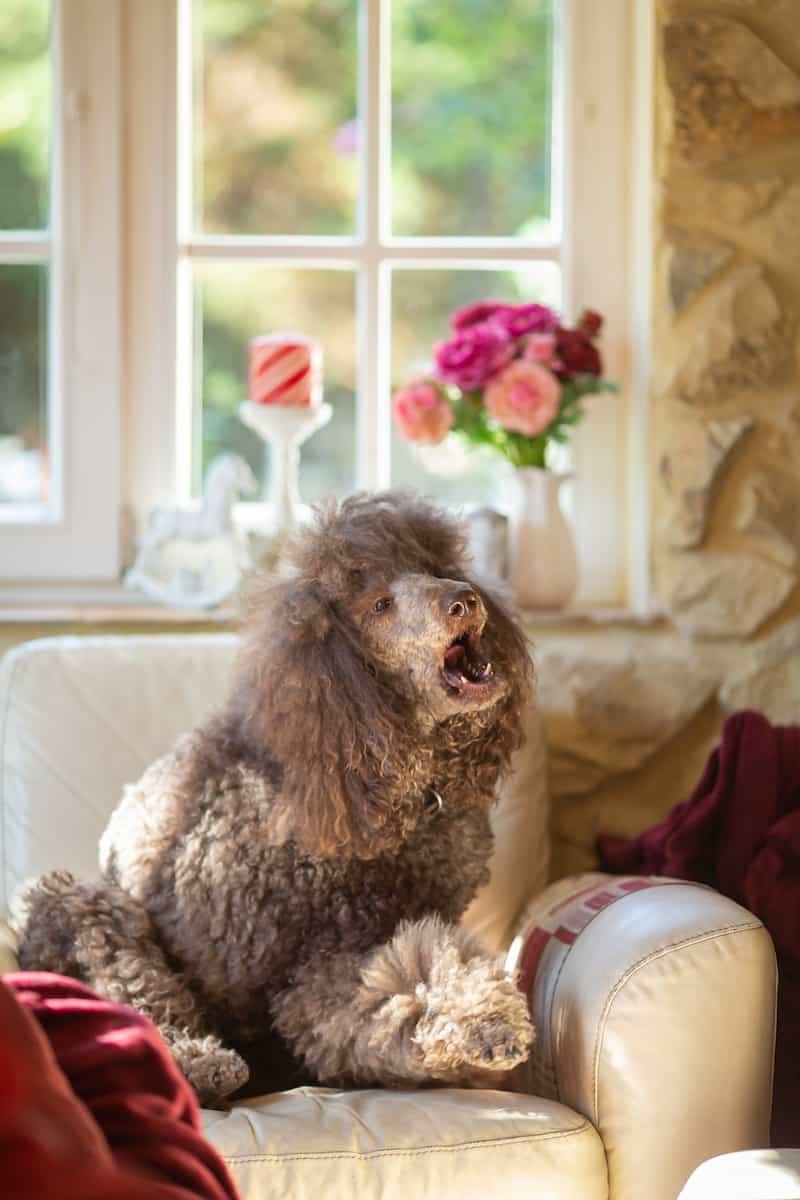
Do you have a poodle that gets anxious or scared when introduced to new environments? It can be difficult to watch them struggle with fear and anxiety. Fortunately, there are steps you can take to help your poodle feel more comfortable in unfamiliar surroundings and ease into them with less stress.
Poodles are known for their intelligence and affectionate nature, but they can also be prone to anxiety and fearfulness. This can make it challenging to take them to new places, whether it’s a park, a friend’s house, or even your own backyard.
When it comes to helping a fearful poodle adapt to new environments, patience and consistency are key. Start by making your poodle feel comfortable in the new environment. Make sure he has all his favorite toys, treats, and comforts from home with him. Gradually introduce your poodle to the new space by taking him on short walks around the area and letting him sniff around and explore at his own pace.
It’s also important to pay attention to your poodle’s body language. Fearful behavior towards people and pets in dogs can include avoiding eye contact, crouching down low, and tucking their tail between their legs. Signs of anxiety can also include panting, trembling, and excessive licking or yawning. If you notice any of these signs, take a step back and give your dog some time to adjust.
It’s also important to reward your poodle when they behave in a calm and relaxed manner. Treats and praise can go a long way towards helping your poodle become more confident in new environments. Positive reinforcement works best when it’s done consistently and immediately after the desired behavior.
If you’re looking for ways to help your poodle adapt to new environments, you’ve come to the right place. In this article, we’ll explore some effective strategies for reducing your poodle’s anxiety and helping them feel more confident and secure in new situations. Whether you’re a new poodle owner or have had your furry friend for years, these tips will help you create a happier, more relaxed environment for your beloved pet.
About This Guide
- Real Experience: Written by poodle enthusiasts with years of hands-on experience caring for and training poodles.
- Expert Reviewed: Content verified by certified dog trainers and veterinary professionals.
- Fact-Checked: Information sourced from the AKC, veterinary journals, and breed specialists.
- Last Updated: November 2025
Definition of Fearful Poodle
A fearful poodle is a dog that exhibits signs of anxiety, distress, or unease when exposed to unfamiliar or potentially threatening situations. Fearful behavior can manifest in various ways, including body language, lack of eye contact, and emotional response. This article will talk about why poodles are afraid, common misunderstandings, and ways to help your poodle adjust to new places.
Fearful behavior in poodles is a natural response to stimuli and unfamiliar situations. It is often caused by lack of proper socialization and exposure during the critical development stages of their young life. Fearful responses can be triggered by things such as loud noises, strange people, or new environments. It is important to understand that these reactions are normal for the breed and should not be punished or discouraged .
Causes of Fearful Behavior in Poodles
- Some poodles may have a genetic tendency to be fearful, which can make them more prone to anxiety and stress in new environments or situations.
- Puppies without proper socialization may show fear when faced with new environments, people, or animals due to their lack of experience. Lack of Socialization: Poodles that haven’t been adequately socialized to new environments, people, and animals may be more likely to display fearful behavior when exposed to something unfamiliar.
- Poodles with separation anxiety may get scared when away from their owners, especially in new places.
- Bad experiences in the past, like at an animal shelter or with loud noises, can make poodles scared. Poodles that have experienced traumatic events or negative encounters while in a new environment are more to become fearful when exposed to similar environments.
Signs of a Fearful Dog
- A scared poodle might show anxiety by cowering, trembling, or tucking its tail. A poodle exhibiting fearful behavior may have a hunched body posture, with its head lowered and ears flattened against its head.
- Vocalizations: A fearful poodle may bark, whine, or cry when it is in an unfamiliar environment. It may also hide behind its owner or seek comfort from them.
- Behavioral Changes: A fearful poodle may become overly clingy with its owner and follow them around everywhere. It may also avoid certain activities and resist going to new places.
- Eye Contact: Fearful dogs may avoid eye contact, appear wide-eyed, or show the whites of their eyes, which is a sign of fear.
- Emotional Response: Fearful dogs may whine, growl, or bark in response to new environments or unfamiliar people.
Understanding a Fearful Poodle’s Needs
- What Stimulates the Fear? To effectively address a fearful poodle’s behavior issues, it’s essential to understand the specific triggers that cause the anxiety. This could include loud noises, unfamiliar people, or certain environments.
- Separation Anxiety: Poodles with separation anxiety may require additional support and training to help them overcome their fears and develop calm behavior when separated from their owners.
- Genetic Predisposition to Fearfulness/Lack of Experience: Dogs with a genetic predisposition to fearfulness or those with a lack of experience may benefit from early socialization, positive experiences, and counter-conditioning techniques to help them adapt to new environments.
Misconceptions About Fearful Dogs
- Some fearful dogs may have been abused, but not all of them. Many factors can contribute to fearful behavior, including genetic predisposition, lack of experience, and separation anxiety.
- Not all fearful dogs have had a traumatic experience. Some dogs may simply be more prone to anxiety due to their genetics or lack of experience.
- They’re Just Being Stubborn: Fearful behavior should not be mistaken for stubbornness. When a dog exhibits signs of fear, it’s essential to address the underlying issues and provide a safe and supportive environment to help the dog feel more at ease.
- Petting or Consoling Them Will Reinforce the Fear: While it’s essential to provide comfort and reassurance to a fearful dog, petting or consoling the dog when it’s in a scary situation can actually reinforce the fear. Instead, focus on using positive reinforcement and counter-conditioning techniques to help the dog overcome its fears.
Counter-Conditioning and Positive Reinforcement Techniques for Dealing with a Fearful Poodle in New Environments
- Introducing your poodle to new people, noises, and situations in a controlled setting can reduce fear and anxiety. Counter-conditioning uses positive experiences to change a dog’s fearful emotions.
- Rewarding your poodle for staying calm in new places can reinforce good behavior. Consistently rewarding positive behavior helps create a rewarding experience for your dog, which can make adapting to new situations easier.
- Gradually exposing your poodle to the fearful thing can help it get used to its surroundings. This may involve escalating the volume of a loud noise or slowly introducing new people or animals into the environment.
- Building Confidence: Encouraging your poodle to explore new environments at its own pace can help build confidence and reduce fear. Providing a safe space, such as a crate or designated room, can also help your dog feel more secure in unfamiliar surroundings.
An Animal Behaviorist or Shelter Expert Seeking Professional Can Help
If you’re still having trouble, consider consulting an animal behaviorist for a poodle. These professionals can help your poodle overcome its fears.
Controlled socialization for your poodle helps their emotional development by interacting with other dogs and people in a controlled setting. Socializing a dog helps them get used to new situations and exposes them to the world outside their home.
Use treats or toys to reward your poodle for good behavior when socializing. Start with short, low-stress socialization sessions and gradually increase their exposure to new people and situations.
It’s also important to create a safe, comfortable environment for your poodle when introducing them to the outside world. Ensure that all interactions are supervised and that they are not pushed beyond what they can handle. If your poodle becomes stressed or anxious, take the time to provide comfort and reassurance.
For shelter dogs in particular, it’s important to remember that they may have had negative experiences in the past. It’s essential to take this into consideration when aiding them in adapting to their new environment. Providing a safe, comfortable space and allowing them to set the pace of socialization can help reduce stress and anxiety.
Overall, helping a fearful poodle adapt to new environments is possible with patience and understanding. Remember that every dog is different and will require individualized support. With the right approach, your poodle can learn to be comfortable in its new home.
Conclusion
Helping a fearful poodle adapt to new environments can be a challenging but rewarding experience. To help your poodle feel more confident in new places, understand what causes fear, look for signs of fear, and use positive training methods. In some cases, it may be necessary to seek help from an animal behaviorist or shelter expert for severe anxiety or behavior problems.
By being patient and understanding, you can help your scared poodle adjust to new places and have a happier life. To help your poodle become more confident, create a safe space and use positive reinforcement.
Every dog is different, so listen to your poodle and adjust your methods accordingly. With time and effort, you can help your poodle live a happy and fulfilling life.
Ready to Adopt a Poodle?
Find poodles waiting for their forever home in your area.





